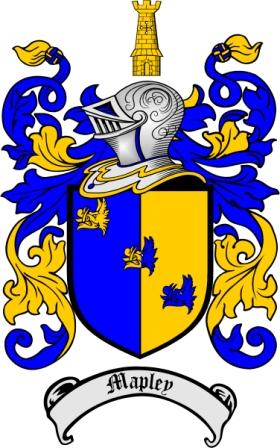|
The Mapley family history
Origin of the name : derived from Amabilis (Latin for friendly), in use in Northern France, it became Anglo-Saxonised
to Mabel as it spread into Cornwall and England beyond, to
eg Mabely, Mapley, Mappeley etc.. Around the time of adoption of surnames, the Norman fashion, the
Hundred Rolls in 1255 and in 1274 listed
in Huntingdonshire (Mabil, Mabilie, Mably), Cambridgeshire (Mabil, Mably, Mabilie, Mabeli) Oxfordshire (Mabely), and Wiltshire
(Mabil) {The Rolls didn't survive for many counties}. Later the name mutated to Mapley in Buckinghamshire, to Mappley in London, and Mabley elsewhere away from Cornwall.
The Mapley family has spread from Newport Pagnell in the 16th. Century, through Wavendon to Little Linford, then Great Linford.
Mapleys spread to other local villages like Little Linford, Hanslope, Castlethorpe,
(New) Bradwell, Great & Little Woolstone.
The Posse Comitatus, or civil power, was a survey of all men capable of acting in a military
capacity who were not either Quakers, clergymen or already serving in a military unit.
Men between the ages of 15 and 60 were included. It was at the initiative of the lord lieutenant,
the Marquess of Buckingham, that the Buckinghamshire survey was conducted in 1798, and remains
the most complete county survey in England. The survey was conducted against the background of war with
revolutionary France, and the risk of invasion by French forces under Napoleon. By February 1798,
Britain had been at war with France for five years. 13 Mapleys were registered as fighting fit in the county.
William Mabley of Wavendon (1689?-1760), then George Mabley (1726-1783) of Wavendon spread the family line, with Thomas Mapley (1753-1824)
moving to Little Linford. With 8, 6 and 11 children respectively. Most Mapleys from the area can be traced back
to these farm labourers and shoemakers.
William's son William Mapley (1779-1851) moved to Great Linford, showing up in the Posse Comitatus of 1798 as a
resident and first of the Great Linford family line. Longevity is a genetic feature of the family, notwithstanding high child
mortality rates, and 3 of William Mapley's sons lived to 80 years old, with further expansion of the family tree.
The Mapleys of Great Linford
The Mapleys of Little Linford
The Mapleys of Newport Pagnell
The Mapleys of Hanslope
The Mapleys of Wavendon
The Mapleys of Great Woolstone
The Mapleys of Castlethorpe
Initially working in the agricultural sector, the advent of a national railway network created
employment for the next generations (1851-)
and also led to migration away from Buckinghamshire. Wolverton Locomotive Works became
the national railway coachworks for the London, Midland & Scottish Railways, Britain's largest railway pre-1948 nationalisation, employing 2,000 workers by 1860 building
rolling stock for some of the most powerful locomotives of all time...
Click here for a more
comprehensive history of the local railways!!
Emigration has also figured in the population patterns - Richard Mapley was tried and shipped to Tasmania, Australia by HMS
Elphinstone in 1844-45, his wife and some of his family joined him 4 years later, and a whole new branch of Mapleys developed
from his family.
As part of the trend to emigrate to the USA (1850-70), William Thomas Mapley of Little Linford married then moved to New York, and the next generation of some of
his 9 kids settled in Michigan and 6-9 kids per generation spread the family rapidly in the new economy.
(several sites are not yet available, sorry...!!)
CENSUS RECORDS:
|
|


